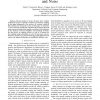Free Online Productivity Tools
i2Speak
i2Symbol
i2OCR
iTex2Img
iWeb2Print
iWeb2Shot
i2Type
iPdf2Split
iPdf2Merge
i2Bopomofo
i2Arabic
i2Style
i2Image
i2PDF
iLatex2Rtf
Sci2ools
111
Voted
GLOBECOM
2007
IEEE
2007
IEEE
Receive Diversity Revisited: Correlation, Coupling and Noise
—Previous studies of receive diversity have carefully modeled the impact of spatial correlation and antenna coupling on the signal component at the receiver. By contrast, relatively little attention has been paid to noise. In this paper we introduce a receive diversity model that articulates the dominant physical noise sources and relates their spatial correlation to the properties of the antennas, front-end amplifiers and matching networks. We then derive an optimal receiver as well as a formula for the resulting outage probability in terms of these noise sources. Numerical results are presented which suggest that different noise sources can impact performance in profoundly different ways.
Related Content
| Added | 02 Jun 2010 |
| Updated | 02 Jun 2010 |
| Type | Conference |
| Year | 2007 |
| Where | GLOBECOM |
| Authors | Carlo P. Domizioli, Brian L. Hughes, Kevin G. Gard, Gianluca Lazzi |
Comments (0)

